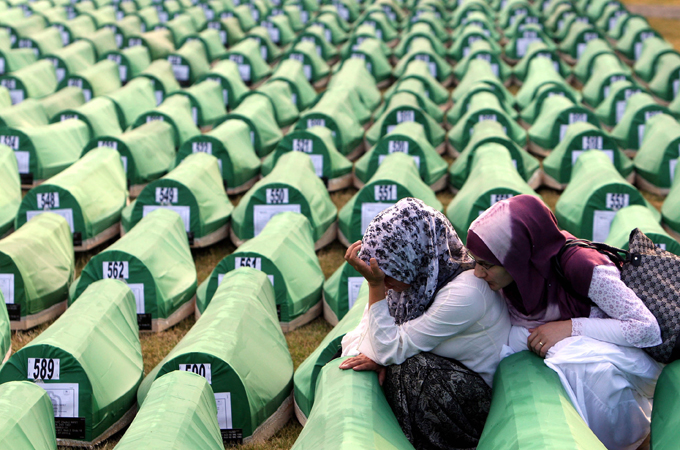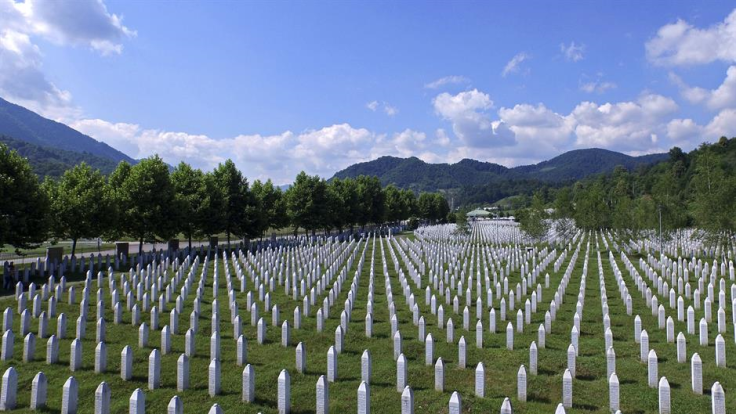Enes Klopic Illustration July 7, 2014
8,372, that’s the number of boys and men killed on July 11, 1995 in Srebrenica, Bosnia and Herzegovina. In a town that was supposed to be a UN safe haven during the Bosnian war, Dutch peacekeepers were unable to keep the Bosnian Serb forces from entering the city, rounding up all the men and boys (officially) over the age of 15, and executing them. Many of them were from nearby villages that arrived in the three years preceding the genocide seeking refuge from the war. 8,372, and that does not include more than 20,000 women, children and elderly that were displaced.
Relatively short in terms of war and armed conflict in general, the Bosnian war lasted from April 6, 1992 to December 14, 1995. By July of ’95, the end seemed imminent, and the loss of the Army of Republika Srpska under the command of General Ratko Mladic seemed a forgone conclusion. Many believe this certainty of defeat is what lead to the mass execution of the civilian population of boys and men. There was little to no justifiable strategic reasoning, even during war. It was nothing short of a desperate, last-minute attempt at ethnic cleansing.
On July 6, 1995, the offensive on Srebrenica began officially. But long before that, the Srpska understood the key to breaking the town. It was a UN safe haven protected by Dutch peacekeepers. Rules of war stated they could not attack the town. So instead, they cut off supplies of food and resources. When people left the town for supplies, the Bosnian Serbs considered these “raiding parties.”
So they used this as a justification to enter Srebrenica. NATO forces planned to attack the artillery locations outside of town, but the VRS threatened to attack other civilian populations and kill their Dutch and French hostages. So the Srpska entered town triumphantly.
In the days that followed, the men and boys were separated from the women. For the most part, they were marched or trucked to wooded areas or the river and executed. Those fleeing through the woods were often coerced back into the trucks by Serb forces wearing UN peacekeeping uniforms and helmets taken from the Dutch forces. Not only were they thrown unceremoniously into mass graves, but the soldiers were ordered to return and move the bodies to other locations to avoid the real numbers being known.
Twenty two years later, graves are still being found. There are now approximately 7,000 souls interred at the Srebrenica-Potocari Memorial and Cemetery. More than a thousand are still missing. Every year on this day, July 11, more families finally have a chance to say goodbye to a son, father, brother, husband as DNA provides the evidence to ensure each person receives the proper recognition he deserves.
I encourage you to please, please learn more about the atrocities that took place such a short time ago. I was in high school when this occurred. This is not the ancient past, or even the memories of our grandparents. This is our past. Mladic was not even arrested for his war crimes until 2011. I recommend this article in The New York Times: Life in the Valley of Death. I also recommend this blog, but I warn you, the images are graphic. Srebrenica Genocide.
The artwork is based on a symbol of remembrance of the genocide at Srebrenica. Traditionally, the flower is crocheted, a popular art of Bosnia. It was designed by the members of the association “Gracanica’s Crochet.” The white petals signify innocence, the green center hope. There are always eleven petals for the day, July 11. Here is some more information about the design of the flower Flower of Srebrenica.
Enes Klopic takes this symbol, and transforms it into a beautifully haunting memorial to the lives lost. The petals are eleven mourning women clothed in white. They encircle a casket, covered in the traditional green Islamic covering. Each have their right arm outstretched, touching the green cloth together, almost as one.
While most have their heads down looking at the casket, a few have their heads lifted, faces toward the skies. But this is also the viewpoint of us, the viewer. We are looking down from above. The upturned faces seem to plead with us to see what they see, feel what they touch, and remember.
And one particular woman seems to stare right at you, as the viewer, although we do not see her eyes. The mother on the top right appears to ask where you were when her child was marched away and executed, and tossed into a mass grave. She seems to not quite accuse you, the viewer, as the perpetrator of the crime, but as a silent witness that stood by and let it happen.
Enes Klopic is a graphic designer from Bosnia who studied at the Academy of Fine Arts in Sarajevo. He now lives in Germany. His Facebook page has a larger version of this piece, with the Srebrenica skyline at night in the foreground. The flower is above, almost like a bright, full moon.
Read more about what the artist has to say about the work here: Enes Klopic (although Google Translator doesn’t seem to do a great job with Bosnian.) I also spoke with him about the piece via Facebook to ask for his permission to post this blog. He was very gracious and humble, saying his flower is free to share with everyone. It is the lives of those lost we need to remember.

I really wanted to actually list all 8,372 names here instead of just posting a link. Unfortunately, every time I tried that, the paged locked up. The sheer number of names locked up my whole system. So instead, please click here Srebrenica Victims to read all of their names.

